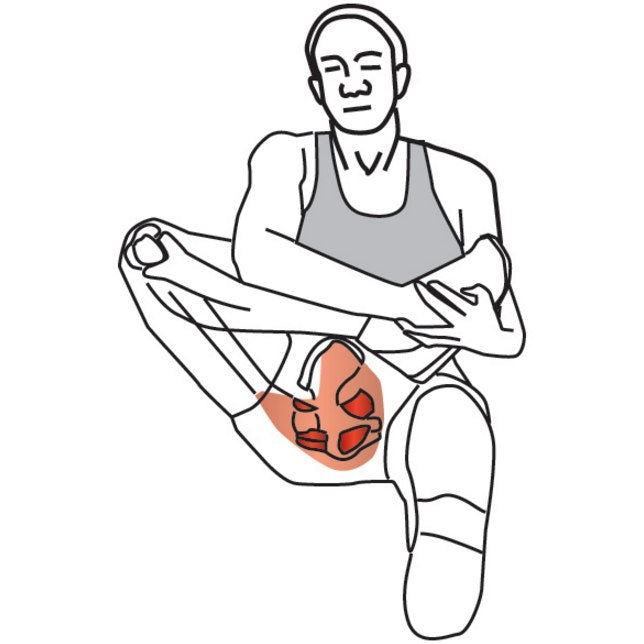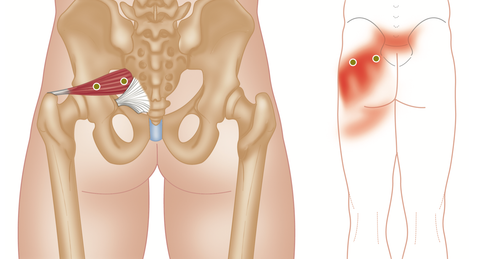Piriformis Syndrome | Finding Trigger Points

Piriformis Stretch - See Instructions Below

Piriformis Muscle Trigger Points
Your Sciatica-type Pain Could Be Caused by Piriformis Syndrome
So called "Piriformis Syndrome" is a condition in which the piriformis muscle, located deep in the buttock region, spasms or contracts to cause a deep shooting type pain through the buttocks and usually down the back of the leg.
This typically happens when the piriformis muscle irritates the sciatic nerve which runs close by the muscle and in some cases even runs through the middle of the muscle.
In addition to the shooting type pain, the symptoms of piriformis syndrome may also include tingling feeling and numbness also deep in the back of the leg and into and similar to common sciatic symptoms.
For relief, try some very gentle stretches for the piriformis. We like the stretch below because just about anyone can do this.
The most important thing is to start extremely slowly and stop as soon as you feel any pain.
If symptoms continue or have been around for a wile, make sure to seek suitable professional advice before attempting any stretching program.

Technique:
Sit with one leg straight and hold onto your other ankle. Pull it directly towards your chest.
Primary muscles: Piriformis. Gemellus superior and inferior. Obturator internus and externus. Quadratus femoris.
Secondary muscle: Gluteus maximus.
Injury where stretch may be useful: Piriformis syndrome. Snapping hip syndrome. Trochanteric bursitis.
Note: Use your hands and arms to regulate the intensity of this stretch. The closer you pull your foot to your chest, the more intense the stretch.

Technique:
- Sit with the soles of your feet together and bring your feet towards your groin
- Hold onto your ankles
- Push your knees towards the ground using your elbows
- Make sure to keep you back straight and upright
Primary muscles: Adductor longus, brevis, and magnus.
Secondary muscles: Pronator teres. Flexor carpi radialis. Flexor carpi ulnaris. Gracilis. Pectineus.
Injury where stretch may be useful: Avulsion fracture in the pelvic area. Groin strain. Osteitis pubis. Piriformis syndrome. Tendonitis of the adductor muscles. Trochanteric bursitis.
Note: In order to regulate the intensity of the stretch, keep your back straight and increase or decrease the strength placed by your elbows.
This blog is intended to be used for general information purposes only and is not intended to be used for medical diagnosis or treatment or to substitute for a medical diagnosis and/or treatment rendered or prescribed by a physician or competent healthcare professional. This information is designed as educational material, but should not be taken as a recommendation for treatment of any particular person or patient.
Always consult your physician if you think you need treatment or if you feel unwell.
About Niel Asher Education
Niel Asher Education (NAT Global Campus) is a globally recognised provider of high-quality professional learning for hands-on health and movement practitioners. Through an extensive catalogue of expert-led online courses, NAT delivers continuing education for massage therapists, supporting both newly qualified and highly experienced professionals with practical, clinically relevant training designed for real-world practice.
Beyond massage therapy, Niel Asher Education offers comprehensive continuing education for physical therapists, continuing education for athletic trainers, continuing education for chiropractors, and continuing education for rehabilitation professionals working across a wide range of clinical, sports, and wellness environments. Courses span manual therapy, movement, rehabilitation, pain management, integrative therapies, and practitioner self-care, with content presented by respected educators and clinicians from around the world.
Known for its high production values and practitioner-focused approach, Niel Asher Education emphasises clarity, practical application, and professional integrity. Its online learning model allows practitioners to study at their own pace while earning recognised certificates and maintaining ongoing professional development requirements, making continuing education accessible regardless of location or schedule.
Through partnerships with leading educational platforms and organisations worldwide, Niel Asher Education continues to expand access to trusted, high-quality continuing education for massage therapists, continuing education for physical therapists, continuing education for athletic trainers, continuing education for chiropractors, and continuing education for rehabilitation professionals, supporting lifelong learning and professional excellence across the global therapy community.

Continuing Professional Education
Looking for Massage Therapy CEUs, PT and ATC continuing education, chiropractic CE, or advanced manual therapy training? Explore our evidence-based online courses designed for hands-on professionals.


















